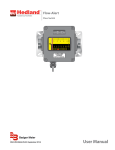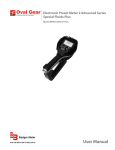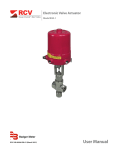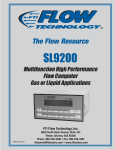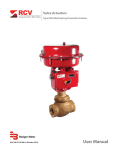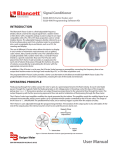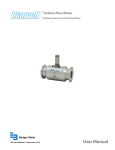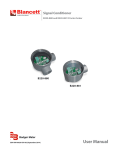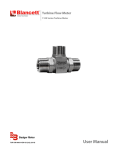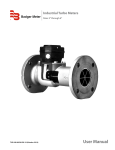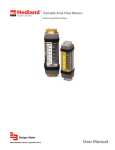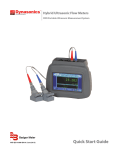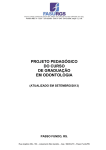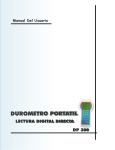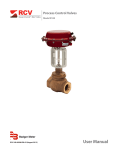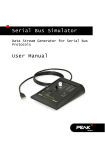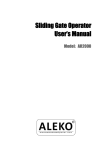Download Turbine Flow Meter
Transcript
Turbine Flow Meter B1500 Series Shown with Blancett B3000 TRB-UM-01798-EN-01 (October 2015) User Manual Turbine Flow Meter, B1500 Series Page ii TRB-UM-01798-EN-01 October 2015 User Manual CONTENTS Description and Use . . . . . . . . . . . . . . . . . . . . . . . . . . . . . . . . . . . . . . . . . . . . . . . . . . . . . . . . . . . . . . . . . . . . 5 Safety information . . . . . . . . . . . . . . . . . . . . . . . . . . . . . . . . . . . . . . . . . . . . . . . . . . . . . . . . . . . . . . . . . . . . . 6 Safety Symbol Explanations . . . . . . . . . . . . . . . . . . . . . . . . . . . . . . . . . . . . . . . . . . . . . . . . . . . . . . . . . . . . 6 Unpacking & Inspection . . . . . . . . . . . . . . . . . . . . . . . . . . . . . . . . . . . . . . . . . . . . . . . . . . . . . . . . . . . . . . . . . .6 Installation . . . . . . . . . . . . . . . . . . . . . . . . . . . . . . . . . . . . . . . . . . . . . . . . . . . . . . . . . . . . . . . . . . . . . . . . . . 6 Meter Orientation . . . . . . . . . . . . . . . . . . . . . . . . . . . . . . . . . . . . . . . . . . . . . . . . . . . . . . . . . . . . . . . . . . .6 Piping . . . . . . . . . . . . . . . . . . . . . . . . . . . . . . . . . . . . . . . . . . . . . . . . . . . . . . . . . . . . . . . . . . . . . . . . . . 6 Disassembly . . . . . . . . . . . . . . . . . . . . . . . . . . . . . . . . . . . . . . . . . . . . . . . . . . . . . . . . . . . . . . . . . . . . . . . . . 7 B1500 Ball Bearing Type . . . . . . . . . . . . . . . . . . . . . . . . . . . . . . . . . . . . . . . . . . . . . . . . . . . . . . . . . . . . . . .7 Cleaning . . . . . . . . . . . . . . . . . . . . . . . . . . . . . . . . . . . . . . . . . . . . . . . . . . . . . . . . . . . . . . . . . . . . . . . . . . . .7 Cleaning a Turbine Meter after Water Calibration and/or Service . . . . . . . . . . . . . . . . . . . . . . . . . . . . . . . . . . . . .7 Reassembly . . . . . . . . . . . . . . . . . . . . . . . . . . . . . . . . . . . . . . . . . . . . . . . . . . . . . . . . . . . . . . . . . . . . . . . . . .8 Troubleshooting . . . . . . . . . . . . . . . . . . . . . . . . . . . . . . . . . . . . . . . . . . . . . . . . . . . . . . . . . . . . . . . . . . . . . . .8 Technical Terms . . . . . . . . . . . . . . . . . . . . . . . . . . . . . . . . . . . . . . . . . . . . . . . . . . . . . . . . . . . . . . . . . . . . . . .9 K-Factor . . . . . . . . . . . . . . . . . . . . . . . . . . . . . . . . . . . . . . . . . . . . . . . . . . . . . . . . . . . . . . . . . . . . . . . . . 9 Repeatability . . . . . . . . . . . . . . . . . . . . . . . . . . . . . . . . . . . . . . . . . . . . . . . . . . . . . . . . . . . . . . . . . . . . . .9 Linearity . . . . . . . . . . . . . . . . . . . . . . . . . . . . . . . . . . . . . . . . . . . . . . . . . . . . . . . . . . . . . . . . . . . . . . . . .9 Factors Affecting Linearity . . . . . . . . . . . . . . . . . . . . . . . . . . . . . . . . . . . . . . . . . . . . . . . . . . . . . . . . . . . . . . . . 9 Size . . . . . . . . . . . . . . . . . . . . . . . . . . . . . . . . . . . . . . . . . . . . . . . . . . . . . . . . . . . . . . . . . . . . . . . . . . . .9 Bearings . . . . . . . . . . . . . . . . . . . . . . . . . . . . . . . . . . . . . . . . . . . . . . . . . . . . . . . . . . . . . . . . . . . . . . . . .9 Pickoffs . . . . . . . . . . . . . . . . . . . . . . . . . . . . . . . . . . . . . . . . . . . . . . . . . . . . . . . . . . . . . . . . . . . . . . . . . .9 Fluids . . . . . . . . . . . . . . . . . . . . . . . . . . . . . . . . . . . . . . . . . . . . . . . . . . . . . . . . . . . . . . . . . . . . . . . . . . .9 Mounting for Calibration . . . . . . . . . . . . . . . . . . . . . . . . . . . . . . . . . . . . . . . . . . . . . . . . . . . . . . . . . . . . . 10 Pressure Drop . . . . . . . . . . . . . . . . . . . . . . . . . . . . . . . . . . . . . . . . . . . . . . . . . . . . . . . . . . . . . . . . . . . . 10 Specific Gravity . . . . . . . . . . . . . . . . . . . . . . . . . . . . . . . . . . . . . . . . . . . . . . . . . . . . . . . . . . . . . . . . . . . . 10 Pressure . . . . . . . . . . . . . . . . . . . . . . . . . . . . . . . . . . . . . . . . . . . . . . . . . . . . . . . . . . . . . . . . . . . . . . . . 10 Temperature . . . . . . . . . . . . . . . . . . . . . . . . . . . . . . . . . . . . . . . . . . . . . . . . . . . . . . . . . . . . . . . . . . . . . 10 Associated Equipment . . . . . . . . . . . . . . . . . . . . . . . . . . . . . . . . . . . . . . . . . . . . . . . . . . . . . . . . . . . . . . . 10 Calibration Data . . . . . . . . . . . . . . . . . . . . . . . . . . . . . . . . . . . . . . . . . . . . . . . . . . . . . . . . . . . . . . . . . . . . . . 11 K-Factor . . . . . . . . . . . . . . . . . . . . . . . . . . . . . . . . . . . . . . . . . . . . . . . . . . . . . . . . . . . . . . . . . . . . . . . . 11 Pressure Rating . . . . . . . . . . . . . . . . . . . . . . . . . . . . . . . . . . . . . . . . . . . . . . . . . . . . . . . . . . . . . . . . . . . 11 Recalibration . . . . . . . . . . . . . . . . . . . . . . . . . . . . . . . . . . . . . . . . . . . . . . . . . . . . . . . . . . . . . . . . . . . . . . . . 12 October 2015 TRB-UM-01798-EN-01 Page iii Turbine Flow Meter, B1500 Series Specifications . . . . . . . . . . . . . . . . . . . . . . . . . . . . . . . . . . . . . . . . . . . . . . . . . . . . . . . . . . . . . . . . . . . . . . . 12 Flow Ranges . . . . . . . . . . . . . . . . . . . . . . . . . . . . . . . . . . . . . . . . . . . . . . . . . . . . . . . . . . . . . . . . . . . . . 13 Pressure Ratings . . . . . . . . . . . . . . . . . . . . . . . . . . . . . . . . . . . . . . . . . . . . . . . . . . . . . . . . . . . . . . . . . . . 13 Pressure Ratings for Flange End Fittings (in accordance with ASME B16.5 Standards) . . . . . . . . . . . . . . . . . . . . . . . 13 Dimensions . . . . . . . . . . . . . . . . . . . . . . . . . . . . . . . . . . . . . . . . . . . . . . . . . . . . . . . . . . . . . . . . . . . . . . . . . 14 Meter Dimensions . . . . . . . . . . . . . . . . . . . . . . . . . . . . . . . . . . . . . . . . . . . . . . . . . . . . . . . . . . . . . . . . . . 14 Monitor Dimensions . . . . . . . . . . . . . . . . . . . . . . . . . . . . . . . . . . . . . . . . . . . . . . . . . . . . . . . . . . . . . . . . 15 Page iv TRB-UM-01798-EN-01 October 2015 Description and Use DESCRIPTION AND USE Blancett B1500 flow meters are precisely manufactured and calibrated instruments used in accurate rate-of-flow and total-flow measurement. The flow meter mounts directly in the flow line and consists of a cylindrically bored housing, a flow straightener and turbine assembly, and a magnetic pickoff, as shown in Figure 1. The magnetic pickoff is located directly above the turbine, near the downstream end of the flow meter. The flow straightener and turbine assembly is retained in the housing by a snap ring and can be easily removed for cleaning and further disassembly. Figure 1: Turbine flow meter Blancett B1500 flow meters are provided with flow straighteners at the downstream and upstream ends. The flow straighteners diminish any turbulence created by the turbine. Other physical differences are illustrated in exploded views. See Figure 1. Fluid passing through the meter causes the rotor and bearing to revolve at a speed directly proportional to fluid velocity. As each rotor blade passes the pickoff, it varies the pickoff’s reluctance, producing an output signal. Since turbine speed is directly proportional to fluid velocity, signal frequency is similarly proportional to the volumetric rate-of-flow. The output signal can be fed into various types of instruments, such as indicators, frequency converters, counters, recorders and controllers to indicate the rate-of-flow. The Blancett B1500 flow meter is designed to provide a high frequency output voltage at the maximum of their flow range. This high frequency signal improves resolution and the standardized output permits several overlapping range flow meters to be connected in series to one indicating instrument. Data concerning extended ranges, specific output voltage and other frequency ranges is available from the factory. October 2015 TRB-UM-01798-EN-01 Page 5 Safety information SAFETY INFORMATION The installation of the Blancett B1500 flow meters must comply with all applicable federal, state, and local rules, regulations, and codes. Failures to read and follow these instructions can lead to misapplication or misuse of the Blancett B1500 flow meters, resulting in personal injury and damage to equipment. Safety Symbol Explanations DANGER INDICATES A HAZARDOUS SITUATION, WHICH, IF NOT AVOIDED IS ESTIMATED TO BE CAPABLE OF CAUSING DEATH OR SERIOUS PERSONAL INJURY. INDICATES A HAZARDOUS SITUATION, WHICH, IF NOT AVOIDED COULD RESULT IN SEVERE PERSONAL INJURY OR DEATH. INDICATES A HAZARDOUS SITUATION, WHICH, IF NOT AVOIDED IS ESTIMATED TO BE CAPABLE OF CAUSING MINOR OR MODERATE PERSONAL INJURY OR DAMAGE TO PROPERTY. UNPACKING & INSPECTION Upon opening the shipping container, visually inspect the product and applicable accessories for any physical damage such as scratches, loose or broken parts, or any other sign of damage that may have occurred during shipment. NNOTE: If damage is found, request an inspection by the carrier's agent within 48 hours of delivery and file a claim with the carrier. A claim for equipment damage in transit is the sole responsibility of the purchaser. INSTALLATION Meter Orientation Blancett B1500 flow meters may be installed in any position without affecting performance. Make sure the direction of flow is the same direction as the arrow engraved on the flow meter body. Piping Install a minimum of 10 pipe diameters of straight pipe or tube in the same size as the flow meter on the upstream side, and 5 diameters on the downstream side to avoid creating turbulence in the liquid, which can cause incorrect flow meter output. If space prohibits the use of these straight sections, install the piping to produce as straight and smooth a flow as possible. BLEED ALL AIR AND VAPOR FROM THE LIQUID AFTER INSTALLING OR REINSTALLING A FLOW METER. START FLOW SLOWLY TO AVOID SENDING A “SLUG” OF HIGH VELOCITY AIR OR VAPOR THROUGH THE FLOW METER AND CAUSING IT TO OVERSPEED. START REQUIRED FLOW AFTER FLOW METER IS FULL OF LIQUID. AERATED LIQUIDS FLOWING THROUGH A FLOW METER WILL RESULT IN INCORRECT FLOW RATES. Page 6 TRB-UM-01798-EN-01 October 2015 Disassembly DISASSEMBLY B1500 Ball Bearing Type 1. Firmly hold the flow meter and, using tweezers, carefully remove internal snap ring from the upstream end. 2. Use long nose pliers to grasp one vane of the flow straightener and gently pull the flow straightener and rotor assembly from the body. Use a slight twisting motion. 3. Press down on the hub to relieve spring pressure on the C-washer and remove with tweezers or thin nosed pliers. 4. Remove hub, spring and spacer. 5. Carefully remove the rotor from the shaft. 6. Remove the snap ring from the side of the bearing and push the bearing out of the rotor. CLEANING Immerse all parts, except the pickoff, in a clean, filtered solvent suitable for removing residue from the liquid used with the flow meter. If necessary, use a soft bristle brush. If there is foreign matter in the ball bearings, soak the bearings in the solvent for approximately 10 minutes and then dry with filtered compressed air. Do not use excessive air pressure. NNOTE: Do not sonic clean the bearings. EXERCISE EXTREME CARE DURING THE CLEANING PROCESS SO NONE OF THE PARTS ARE DROPPED, SCRATCHED OR DAMAGED IN ANY WAY. DO NOT ATTEMPT TO FURTHER POLISH ANY OF THE PARTS, ESPECIALLY THE ROTOR. Cleaning a Turbine Meter after Water Calibration and/or Service NNOTE: When cleaning flow meters, keep the body, sleeve and pickoff together. The sleeve is fitted to the body and the pickoff has a protruding pin. Replacement pickoffs are supplied with a nut and have no protruding pin. 1. Remove the meter from the line and let all excess water drip out. 2. Fill the meter with alcohol, at least 50% Isopropyl, Ethyl or Methyl, and let it stand for 5 minutes. 3. Discard the alcohol and let the meter dry for 2 minutes. 4. Fill the meter with MIL-C-7024 Type 2 calibration fluid, or similar solvent, and let it stand for 1 minute. 5. Discard the calibration fluid and flush the meter with an approved fluorocarbon solvent, such as Isotron. NNOTE: If this procedure is not possible, make sure the turbine meter is always filled with water when not in use, to prevent internal wetted parts from being exposed to air. Figure 2: B1500 turbine flow meter DO NOT INTERCHANGE FLOW METER PARTS OTHER THAN BEARINGS AND RETAINING RINGS. THIS PRECAUTION IS NECESSARY TO PRESERVE LINEARITY AND REPEATABILITY. October 2015 TRB-UM-01798-EN-01 Page 7 Reassembly REASSEMBLY Reassembly is the reverse of disassembly except for the following: • On flow meters where shaft bearings are provided with a retainer, always install with the retainer flange facing upstream. • Inspect the rotor for markings as shown in Figure 3 to indicate flow direction before assembly. • Flow meters that have broached slots in the body for flow straightener vanes should be carefully assembled. • Align the straightener vanes with the slots and push gently until the assembly is seated. Figure 3: Scribed lines TROUBLESHOOTING Issue Meter indicates higher flow than actual Meter indicates high flow Meter indicates low flow Meter indicates low flow Possible Cause Cavitation Dirt blocking flow area rotor Dirt dragging rotor Worn bearing Meter indicates low flow Viscosity higher than calibrated Erratic system indication; meter alone works well Ground loop is shielding No flow indication; full flow of fluid opened into dry meter; impact of fluid on rotor causes bearing separation Fluid shock. New bearing failed Erratic indication at low flow; good indication at high flow Low instrument sensitivity; 10 mV rms turbine signal is being lowered by loading of electronics or instrumentation cannot sense low level signals Faulty pickoff No flow indication System works perfectly, except indicates Bypass flow, leak lower flow over entire range Fluid jet impingement on rotor Meter indicating high flow; upstream piping at meter smaller than meter Critical in gas Opposite effects as above Mass flow indication wrong Turbine meter is volumetric; density correction is electronic; must change with temperature Erratic or wrong indication of flow Indicates high flow two hours after installing new bearing. Cannot reach maximum flow rate; meter selection was with Delta-P at 0.75 sp. gr., now using on 1.0 sp. gr. Delta-P is proportional to specific gravity Does not repeat at low flows; repeats at high flows Page 8 Remedy Increase back pressure Clean meter; add filter Clean meter; add filter Replace bearing; recalibrate when required Change temperature; change fluid; recalibrate meter Ground shield one place only Watch for internal electronic instrument grounds Move meter to position where it is full of fluid at start-up Amplify signal Replace pickoff; recalibrate as necessary Eliminate bypass valves, leak Faulty solenoid valves Change piping Viscosity lower than calibrated Change temperature; change fluid; recalibrate meter Wrong fluid density Critical in gas Check fluid, electronics Loose pickoff Tighten pickoff Recalibrate; 20…30 min. run-in is required Bearing wear-in; small meters critical to stabilize friction High pressure drop Install larger meter System resolution readability Increase resolution, for example: 1 out of 100 = 1% 1 out of 1000 = 0.1% TRB-UM-01798-EN-01 October 2015 Technical Terms TECHNICAL TERMS K-Factor “K” is a letter used to denote the cycles-per-gallon factor of a flow meter. This factor is a fixed value used in resolving or totalizing the pulse count output of a flow meter. It results from the equation: Cycles per second/Gallons per second = Cycles per gallon (K) Repeatability The maximum deviation from the corresponding data points taken from repeated tests under identical conditions. Linearity The deviation from the mean calibration factor (K), expressed as being within a certain tolerance. FACTORS AFFECTING LINEARITY Size The size of the meter selected is determined by the flow range required and the fluid characteristics. Standard flow ranges are listed in “Flow Ranges” on page 13. Where range requirements fall between the listed ranges, use two meters, or you can order a meter for the specific range required. Overspeeding to meet a required flow capacity results in lowered operating life. Going to a larger meter size to avoid overspeeding results in the non-linear range at the lower flow rates. Bearings The rotor in a standard meter is mounted on ball bearings. The function of rolling friction in regard to linear operating range is nil and can be disregarded. Pickoffs Magnetic pickoffs affect the linear range of a meter, due to magnetic drag on the rotor. Since the turning force available is a function of the total mass flow, the low capacity meters are more affected at the minimum flow rate than the high capacity meters. Replacement pickoffs should have the same part number as original equipment, otherwise the linear range can be affected. Fluids There are two types of fluids: compressible and incompressible. Considering only the incompressible (liquids), there are three factors that affect the linear flow range. They are lubricity, density and viscosity. Lubricity This is not a measurable quantity. It is that property of a liquid that determines the friction within the bearing and affects the life of the bearing, as well as the linear operating range. Lack of lubricity can cause erratic action, especially at the low end of the flow range. Density Turbine flow meters are designed to operate over the standard frequency range with liquids of 1.0 specific gravity (H2O). If a liquid of 1.5 specific gravity is used, it will have a 50% increase in driving force available at a given frequency. Also, the differential pressure of the meter is increased a like amount. This increased differential pressure can reduce the life of the bearing. Reduction of maximum operating frequency to maintain design pressure drop results in reduced bearing life. The maximum frequency can be approximately calculated as shown by the following example: 𝑀𝑀𝑀𝑀𝑀𝑀𝑀𝑀𝑀𝑀𝑀𝑀𝑀𝑀 𝐹𝐹𝐹𝐹𝐹𝐹𝐹𝐹𝐹𝐹𝐹𝐹𝐹𝐹𝐹𝐹𝐹𝐹 = 1200 �1.0/1.5 = 980 𝑐𝑐𝑐𝑐𝑐𝑐 Figure 4: Calculating maximum frequency October 2015 TRB-UM-01798-EN-01 Page 9 Factors Affecting Linearity Viscosity In a turbine meter, the one factor that most affects the linear range is viscosity. The skin friction (viscous affect of the boundary layers) on the blades of the rotor and adjacent surfaces, is known to be a function of the Reynolds number (a dimensionless parameter). At a sufficiently low Reynolds number, the boundary layer is completely laminar. At a high Reynolds number, the boundary layer is turbulent. In the transition region, there is a gradual change from laminar to turbulent flow. At low viscosities, the Reynolds number is high, so that at the minimum operating frequency the flow is still turbulent. As the viscosity is increased, the Reynolds number decreases and the meter (at the same minimum frequency) is operating in the transition region. At this point, the drag actually decreases and the K-factor (cycles per gallon) increases. A further increase in viscosity and the Reynolds number decreases to a point where the flow is completely laminal and the K-factor decreases. In effect, as the viscosity increases, the range in which the flow is turbulent decreases. In low capacity flow meters, the viscosity effect may be of such an order that the entire flow range will be in the laminar flow region. Mounting for Calibration Turbine flow meters are calibrated with the axis horizontal and the pickoff on top. Flow meters with ball bearings may be mounted in any attitude with nil affect on the linearity range or calibration. Pipe configuration, such as valves, tees and elbows immediately preceding the meter, can produce swirl in the fluid with erroneous results. Install a minimum of 10 diameters of tubing the same size as the meter. Pressure Drop Pressure drop across turbine flow meters is substantially constant for a given gravimetric flow rate, but varies in approximate proportion to the square of the volumetric flow rate. This variation is proportional to a liquid’s density. The values shown under range characteristics are based on a liquid specific gravity of 0.760 and a viscosity of 1 centistoke. Specific Gravity Changes in the specific gravity of a liquid in a linear shift in gravimetric calibration can be plotted as a function of specific gravity. These changes have no measurable effect on the volumetric flow rate but will cause a shift in the pressure drop across the flow meter. Pressure Pressure changes have no measurable effect on volumetric flow rates. Temperature Large temperature changes cause an area change within the flow meter. Higher temperature will result in decreased fluid velocity while lower temperature results in increased fluid velocity. This change will cause a variation of the K-factor that is supplied with the turbine flow meter. Turbine flow meters calibrated at one temperature and operated at another require correction of their K-factor. Associated Equipment Electrical leads from the flow meter to remote associated equipment should be carefully chosen to be compatible with the flow meter output and the impedance values of the components used. Distance between flow meter and associated equipment is then a negligible factor. Use good quality coaxial cable or twisted pairs, with or without shielding, as required by environmental factors. If a shielded lead is required, it must not be grounded at the flow meter since neither pin of the standard pickoff is grounded. Ground at some other point to eliminate ground loops in the associated equipment. Page 10 TRB-UM-01798-EN-01 October 2015 Calibration Data CALIBRATION DATA K-Factor The calibration data supplied with a B1500 flow meter is shown in Figure 6. Correct application of a B1500 flow meter requires consideration of many important factors. Because of the wide variation of possible applications, detailed data for liquid flow models only is given in this manual. For special requirements, consult the factory. Pressure Rating Flange flow meters are rated for service pressure according to ANSI ratings for the flanges used. Operation at temperatures above 200° F (93° C) decreases the connection rating because of lowered stress capabilities of the metal. Liquid Formula = =( × 60) ÷ × 3600 × 8.328 × . . . = − Figure 5: Calculating flow rates in different units Certificate of Calibration 8635 Washington Ave • Racine, WI 53406 • Phone: 1-877-243-1010 • Fax: 1-800-245-3569 • [email protected] B150-501-NPT Cal Date: ******** Customer Re-Cal Date: MAG Lab Temp: FDP-002 Lab Relative Humidity: Eddie MIL-C-7024 TY II Specific Gravity: 80 Viscosity (CSTKS): In Tolerance: Meet +/- 0.5% Linearity from 0.2 – 3.0 GPM Nominal K-Factor in GPM = Calibration Results (Initial Calibration) 9/9/2015 Model # Serial # Signal: Calibration Procedure: Calibration Tech: Fluid Specifications: Temperature (F): Notes, Adjustments & Repairs Test Point # 1 2 3 4 5 6 7 8 9 10 Frequency Hz Flow Rate GPM Freq./ Visc Hz/cstk K Factor pul/gal Flow Rate LPM 75 Deg F 27% 0.762 1.12 Mass Flow PPH Linear COEFF. Standards Used in Calibration Standard # FDI-180 FDI-180 Cart Description 30 GPM Liquid Prover 30 GPM Cart - mA, Vdc, Frequency, Temp NA N/A Serial # ReCal Date 8/12/2018 6/2/2016 The instrument referenced above was calibrated using standards traceable to the National Institute of Standards and Technology. Calibration reports for references maintained by Badger Meter, Inc. are available upon request to the customer of this calibration report. The volumetric flow rates reported are within a best uncertainty of +/- .037% of reading (Represents an expanded uncertainty using a coverage factor, k = 2, at an approximate level of confidence of 95%) and applies to calibration equipment only and +/- 0.02% reading uncertainty of the UUT(Unit Under Test). I certify the accuracy of this Calibration Report: End of Report Andrew Yee Name Calibration Engineer Title Signature Doc Nbr: CRF-002 Rev: G Report #:195165 - 1509000019 Page 1 of 1 Figure 6: Calibration certification October 2015 TRB-UM-01798-EN-01 Page 11 Recalibration RECALIBRATION • Recalibration is not necessary following a cleaning operation or the replacement of bearings, snap rings, springs or spacers. • Recalibrate the flow meter if the rotor hub, or rotor and flow straightener assembly is replaced. • Flow meters may be recalibrated by the user if the facilities are available, or they may be returned to the factory. Yearly calibration is recommended. • When the flow meter is set up for recalibration, allow the fluid to circulate for 5 minutes before beginning the calibrating runs. SPECIFICATIONS Performance Materials of Construction Accuracy ± 0.25% of reading Repeatability ± 0.02% of reading Response Time 2…3 ms (at 1.2 cSt) Body 316 stainless steel Shafts 316 stainless steel Rotors 17-4 PH stainless steel Bearing Ceramic Materials Materials listed in below are used for most turbine flow meter applications. For unusual requirements, such as those outside the range of –300…350° F (–184…176° C) or those with extremely corrosive liquids, consult the factory. Page 12 Part Type Bearing Hybrid ceramic Body 316 C-Washer 302 Hub 303 Locknut CRS (plated) Pickoff 304 Spacer 303 Spring 302 Snap Ring 303 Straightener Assembly 316 Rotor 17-4 SS TRB-UM-01798-EN-01 October 2015 Specifications Flow Ranges Part Number Flow Range ∆P at 10:1 * K-Factor** B150-501 0.25…2.50 gpm (0.9…9.5 lpm) 3.5 PSID (0.25 kg/cm ) 28,800 US gal/min (7910 L/min) B150-502 0.5…5.0 gpm (1.9…18.9 lpm) 4.5 PSID (0.32 kg/cm ) 14,400 US gal/min (3805 L/min) B150-503 0.75…7.50 gpm (2.8…28.4 lpm) 6.0 PSID (0.42 kg/cm ) 9600 US gal/min (2536 L/min) B150-625 1.25…12.50 gpm (4.7…47.3 lpm) 5.0 PSID (0.35 kg/cm ) 5760 US gal/min(1522 L/min) B150-750 2.5…25.0 gpm (9.5…94.6 lpm) 5.0 PSID (0.35 kg/cm ) 2800 US gal/min (761 L/min) B150-110 5.0…50.0 gpm (18.9…189.3 lpm) 5.0 PSID (0.35 kg/cm2) 1440 US gal/min (380 L/min) B150-125 7.5…75.0 gpm (28.3…283.9 lpm) 5.5 PSID (0.39 kg/cm ) 960 US gal/min (254 L/min) B150-115 12.5…125.0 gpm (47.3…473.2 lpm) 6.0 PSID (0.42 kg/cm ) 576 US gal/min (152 L/min) B150-120 25…250.0 gpm (94.6…946.4 lpm) 6.5 PSID (0.46 kg/cm ) 288 US gal/min (76 L/min) 2 2 2 2 2 2 2 2 *Pressure drop is based on using MIL-PRF-17024E, Type II at 77° F (25° C), with a specific gravity of 0.77 **K-Factor will vary slightly from meter to meter Pressure Ratings NPT End Fittings Part Number Nominal Pipe Size B150-501-NPT B150-502-NPT B150-503-NPT B150-625-NPT B150-750-NPT B150-110-NPT B150-125-NPT B150-115-NPT B150-120-NPT 0.25 in. (6.4 mm) 0.37 in. (9.5 mm) 0.50 in. (12.7 mm) 0.75 in. (19.1 mm) 0.75 in. (19.1 mm) 1.00 in. (25.4 mm) 1.25 in. (31.8 mm) 1.50 in. (38.1 mm) 2.00 in. (50.8 mm) psig 5922 4700 4418 4136 4136 4042 4700 4230 3666 Male bar 408 324 305 285 285 278 324 291 253 NOTES: 1. Pressure ratings listed are for temperatures up to 100° F (37.8° C). 2. Pressure rating is calculated with an allowable stress value of 20,000 psi (1378 bar) for 316 SS per pressure piping code ASME B31.3. 3. Chart is displaying safe working pressure, in accordance with power piping code ASME B31.1. Flange End Fittings (in accordance with ASME B16.5 Standards) ANSI Flange 150# PSIG 275 Bar 19 NOTES: 1. Specifications from maximum non-shock allowable working pressure in psig at 100° F (37.8° C) or less. 2. Stainless steel 316A-181 material. October 2015 TRB-UM-01798-EN-01 Page 13 Dimensions DIMENSIONS NPT End Fitting B D C A Part Number End Fitting A B C D B150-501-NPT B150-502-NPT B150-503-NPT B150-625-NPT B150-750-NPT B150-110-NPT B150-125-NPT B150-115-NPT B150-120-NPT 1/2 in. (12.7 mm) 1/2 in. (12.7 mm) 1/2 in. (12.7 mm) 3/4 in. (19.1 mm) 3/4 in. (19.1 mm) 1.00 in. (25.4 mm) 1.25 in. (31.75 mm) 1.50 in. (38.10 mm) 2.00 in. (50.80 mm) 2.70 in. (68.6 mm) 2.70 in. (68.6 mm) 2.70 in. (68.6 mm) 3.29 in. (83.6 mm) 3.29 in. (83.6 mm) 3.78 in. (96.0 mm) 4.23 in. (107.4 mm) 4.67 in. (118.6 mm) 5.89 in. (149.6 mm) 2.52 in. (64.0 mm) 2.52 in. (64.0 mm) 2.62 in. (66.5 mm) 2.62 in. (66.5 mm) 2.72 in. (69.1 mm) 2.82 in. (71.6 mm) 2.92 in. (74.2 mm) 3.12 in. (79.2 mm) 3.32 in. (84.3 mm) 1.12 in. (28.5 mm) Square Body 1.12 in. (28.5 mm) Square Body 1.12 in. (28.5 mm) Square Body 1.25 in. (31.8 mm) Square Body 1.25 in. (31.8 mm) Square Body 1.63 in. (41.4 mm) Hex Body 1.88 in. (47.8 mm) Hex Body 2.25 in. (57.2 mm) Hex Body 2.75 in. (69.9 mm) Hex Body 1.62 in. (40.9 mm) 1.62 in. (40.9mm) 1.62 in. (40.9 mm) 1.75 in. (44.5 mm) 1.75 in. (44.5 mm) 2.13 in. (54.1 mm) 2.38 in. (60.5 mm) 2.75 in. (69.9 mm) 2.75 in. (69.9 mm) Flange End Fitting ØC B D A Size B150-501-F15 B150-502-F15 B150-503-F15 B150-625-F15 B150-750-F15 B150-110-F15 B150-125-F15 B150-115-F15 B150-120-F15 Page 14 A 5.00 in. (127.0 mm) 5.00 in. (127.0 mm) 5.00 in. (127.0 mm) 5.50 in. (139.7 mm) 5.50 in. (139.7 mm) 5.50 in. (139.7 mm) 6.00 in. (152.4 mm) 6.00 in. (152.4 mm) 6.50 in. (165.1 mm) B 2.52 in. (64.0 mm) 2.52 in. (64.0 mm) 2.62 in. (66.5 mm) 2.62 in. (66.5 mm) 2.72 in. (69.1 mm) 2.82 in. (71.6 mm) 2.92 in. (74.2 mm) 3.12 in. (79.2 mm) 3.32 in. (84.3 mm) TRB-UM-01798-EN-01 C 3.50 in. (88.9 mm) 3.50 in. (88.9 mm) 3.50 in. (88.9 mm) 3.50 in. (88.9 mm) 3.88 in. (99.6 mm) 4.25 in. (107.9 mm) 4.62 in. (117.3 mm) 5.00 in. (127.8 mm) 6.00 in. (152.4 mm) D 1.03 in. (26.7 mm) 1.06 in. (26.9 mm) 1.12 in. (28.4 mm) 1.19 in. (30.2 mm) 1.26 in. (32.0 mm) 1.37 in. (34.8 mm) 1.49 in. (37.8 mm) 1.61 in. (40.9 mm) 1.84 in. (46.7 mm) October 2015 User Manual INTENTIONAL BLANK PAGE October 2015 TRB-UM-01798-EN-01 Page 15 Turbine Flow Meter, B1500 Series Control. Manage. Optimize. Blancett is a registered trademark of Badger Meter, Inc. Other trademarks appearing in this document are the property of their respective entities. Due to continuous research, product improvements and enhancements, Badger Meter reserves the right to change product or system specifications without notice, except to the extent an outstanding contractual obligation exists. © 2015 Badger Meter, Inc. All rights reserved. www.badgermeter.com The Americas | Badger Meter | 4545 West Brown Deer Rd | PO Box 245036 | Milwaukee, WI 53224-9536 | 800-876-3837 | 414-355-0400 México | Badger Meter de las Americas, S.A. de C.V. | Pedro Luis Ogazón N°32 | Esq. Angelina N°24 | Colonia Guadalupe Inn | CP 01050 | México, DF | México | +52-55-5662-0882 Europe, Middle East and Africa | Badger Meter Europa GmbH | Nurtinger Str 76 | 72639 Neuffen | Germany | +49-7025-9208-0 Europe, Middle East Branch Office | Badger Meter Europe | PO Box 341442 | Dubai Silicon Oasis, Head Quarter Building, Wing C, Office #C209 | Dubai / UAE | +971-4-371 2503 Czech Republic | Badger Meter Czech Republic s.r.o. | Maříkova 2082/26 | 621 00 Brno, Czech Republic | +420-5-41420411 Slovakia | Badger Meter Slovakia s.r.o. | Racianska 109/B | 831 02 Bratislava, Slovakia | +421-2-44 63 83 01 Asia Pacific | Badger Meter | 80 Marine Parade Rd | 21-06 Parkway Parade | Singapore 449269 | +65-63464836 China | Badger Meter | 7-1202 | 99 Hangzhong Road | Minhang District | Shanghai | China 201101 | +86-21-5763 5412
















